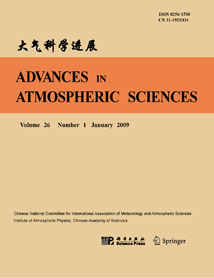| [1] |
Xiaoli XIA, Jinzhong MIN, Feifei SHEN, Yuanbing WANG, Chun YANG,
2019: Aerosol Data Assimilation Using Data from Fengyun-3A and MODIS: Application to a Dust Storm over East Asia in 2011, ADVANCES IN ATMOSPHERIC SCIENCES, 36, 1-14.
doi: 10.1007/s00376-018-8075-9
|
| [2] |
ZHENG Xiaogu, WU Guocan, ZHANG Shupeng, LIANG Xiao, DAI Yongjiu, LI Yong, ,
2013: Using Analysis State to Construct a Forecast Error Covariance Matrix in Ensemble Kalman Filter Assimilation, ADVANCES IN ATMOSPHERIC SCIENCES, 30, 1303-1312.
doi: 10.1007/s00376-012-2133-5
|
| [3] |
Chenwei SHEN, Qingyun DUAN, Chiyuan MIAO, Chang XING, Xuewei FAN, Yi WU, Jingya HAN,
2020: Bias Correction and Ensemble Projections of Temperature Changes over Ten Subregions in CORDEX East Asia, ADVANCES IN ATMOSPHERIC SCIENCES, 37, 1191-1210.
doi: 10.1007/s00376-020-0026-6
|
| [4] |
LI Shan, RONG Xingyao, LIU Yun, LIU Zhengyu, Klaus FRAEDRICH,
2013: Dynamic Analogue Initialization for Ensemble Forecasting, ADVANCES IN ATMOSPHERIC SCIENCES, 30, 1406-1420.
doi: 10.1007/s00376-012-2244-z
|
| [5] |
Kefeng ZHU, Ming XUE, Yujie PAN, Ming HU, Stanley G. BENJAMIN, Stephen S. WEYGANDT, Haidao LIN,
2019: The Impact of Satellite Radiance Data Assimilation within a Frequently Updated Regional Forecast System Using a GSI-based Ensemble Kalman Filter, ADVANCES IN ATMOSPHERIC SCIENCES, 36, 1308-1326.
doi: 10.1007/s00376-019-9011-3
|
| [6] |
Rong KONG, Ming XUE, Edward R. MANSELL, Chengsi LIU, Alexandre O. FIERRO,
2024: Assimilation of GOES-R Geostationary Lightning Mapper Flash Extent Density Data in GSI 3DVar, EnKF, and Hybrid En3DVar for the Analysis and Short-Term Forecast of a Supercell Storm Case, ADVANCES IN ATMOSPHERIC SCIENCES, 41, 263-277.
doi: 10.1007/s00376-023-2340-2
|
| [7] |
Guo DENG, Xueshun SHEN, Jun DU, Jiandong GONG, Hua TONG, Liantang DENG, Zhifang XU, Jing CHEN, Jian SUN, Yong WANG, Jiangkai HU, Jianjie WANG, Mingxuan CHEN, Huiling YUAN, Yutao ZHANG, Hongqi LI, Yuanzhe WANG, Li GAO, Li SHENG, Da LI, Li LI, Hao WANG, Ying ZHAO, Yinglin LI, Zhili LIU, Wenhua GUO,
2024: Scientific Advances and Weather Services of the China Meteorological Administration’s National Forecasting Systems during the Beijing 2022 Winter Olympics, ADVANCES IN ATMOSPHERIC SCIENCES, 41, 767-776.
doi: 10.1007/s00376-023-3206-3
|
| [8] |
Lili LEI, Yangjinxi GE, Zhe-Min TAN, Yi ZHANG, Kekuan CHU, Xin QIU, Qifeng QIAN,
2022: Evaluation of a Regional Ensemble Data Assimilation System for Typhoon Prediction, ADVANCES IN ATMOSPHERIC SCIENCES, 39, 1816-1832.
doi: 10.1007/s00376-022-1444-4
|
| [9] |
Bohua Huang, James L. Kinter III, Paul S. Schopf,
2002: Ocean Data Assimilation Using Intermittent Analyses and Continuous Model Error Correction, ADVANCES IN ATMOSPHERIC SCIENCES, 19, 965-992.
doi: 10.1007/s00376-002-0059-z
|
| [10] |
Xiaogu ZHENG,
2009: An Adaptive Estimation of Forecast Error Covariance Parameters for Kalman Filtering Data Assimilation, ADVANCES IN ATMOSPHERIC SCIENCES, 26, 154-160.
doi: 10.1007/s00376-009-0154-5
|
| [11] |
Banglin ZHANG, Vijay TALLAPRAGADA, Fuzhong WENG, Jason SIPPEL, Zaizhong MA,
2016: Estimation and Correction of Model Bias in the NASA/GMAO GEOS5 Data Assimilation System: Sequential Implementation, ADVANCES IN ATMOSPHERIC SCIENCES, 33, 659-672.
doi: 10.1007/ s00376-015-5155-y
|
| [12] |
Fuqing ZHANG, Meng ZHANG, James A. HANSEN,
2009: Coupling Ensemble Kalman Filter with Four-dimensional Variational Data Assimilation, ADVANCES IN ATMOSPHERIC SCIENCES, 26, 1-8.
doi: 10.1007/s00376-009-0001-8
|
| [13] |
Lei HAN, Mingxuan CHEN, Kangkai CHEN, Haonan CHEN, Yanbiao ZHANG, Bing LU, Linye SONG, Rui QIN,
2021: A Deep Learning Method for Bias Correction of ECMWF 24–240 h Forecasts, ADVANCES IN ATMOSPHERIC SCIENCES, 38, 1444-1459.
doi: 10.1007/s00376-021-0215-y
|
| [14] |
LIU Wei, FENG Qi, WANG Tao, ZHANG Yanwu, SHI Jianhua,
2004: Physicochemistry and Mineralogy of Storm Dust and Dust Sediment in Northern China, ADVANCES IN ATMOSPHERIC SCIENCES, 21, 775-783.
doi: 10.1007/BF02916374
|
| [15] |
ZHANG Renjian, HAN Zhiwei, SHEN Zhenxing, CAO Junji,
2008: Continuous Measurement of Number Concentrations and Elemental Composition of Aerosol Particles for a Dust Storm Event in Beijing, ADVANCES IN ATMOSPHERIC SCIENCES, 25, 89-95.
doi: 10.1007/s00376-008-0089-2
|
| [16] |
T. N. Krishnamurti, Mukul Tewari, Ed Bensman, Wei Han, Zhan Zhang, William K. M. Lau,
1999: An Ensemble Forecast of the South China Sea Monsoon, ADVANCES IN ATMOSPHERIC SCIENCES, 16, 159-182.
doi: 10.1007/BF02973080
|
| [17] |
GAO Feng*, Peter P. CHILDS, Xiang-Yu HUANG, Neil A. JACOBS, and Jinzhong MIN,
2014: A Relocation-based Initialization Scheme to Improve Track-forecasting of Tropical Cyclones, ADVANCES IN ATMOSPHERIC SCIENCES, 31, 27-36.
doi: 10.1007/s00376-013-2254-5
|
| [18] |
Yuejian ZHU,
2005: Ensemble Forecast: A New Approach to Uncertainty and Predictability, ADVANCES IN ATMOSPHERIC SCIENCES, 22, 781-788.
doi: 10.1007/BF02918678
|
| [19] |
Zhongfeng XU, Ying HAN, Meng-Zhuo ZHANG, Chi-Yung TAM, Zong-Liang YANG, Ahmed M. EL KENAWY, Congbin FU,
2024: Assessing the Performance of a Dynamical Downscaling Simulation Driven by a Bias-Corrected CMIP6 Dataset for Asian Climate, ADVANCES IN ATMOSPHERIC SCIENCES, 41, 974-988.
doi: 10.1007/s00376-023-3101-y
|
| [20] |
ZENG Qingcun, CHENG Xueling, HU Fei, PENG Zhen,
2010: Gustiness and Coherent Structure of Strong Winds and Their Role in Dust Emission and Entrainment, ADVANCES IN ATMOSPHERIC SCIENCES, 27, 1-13.
doi: 10.1007/s00376-009-8207-3
|















 AAS Website
AAS Website 
 AAS WeChat
AAS WeChat 
 DownLoad:
DownLoad: